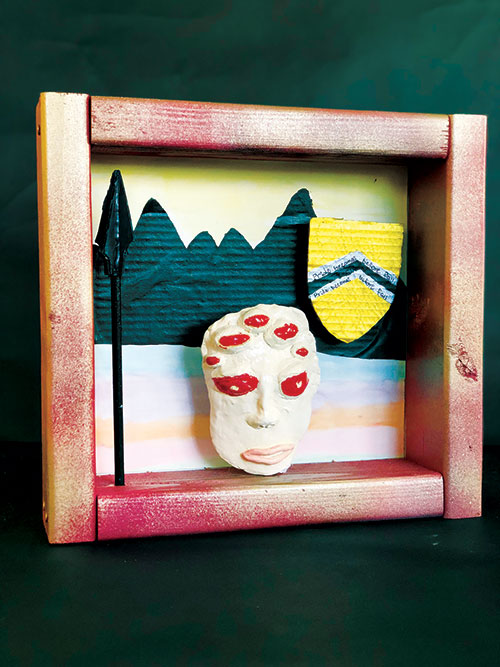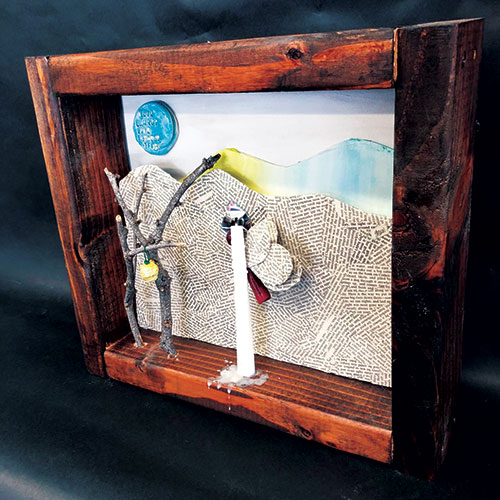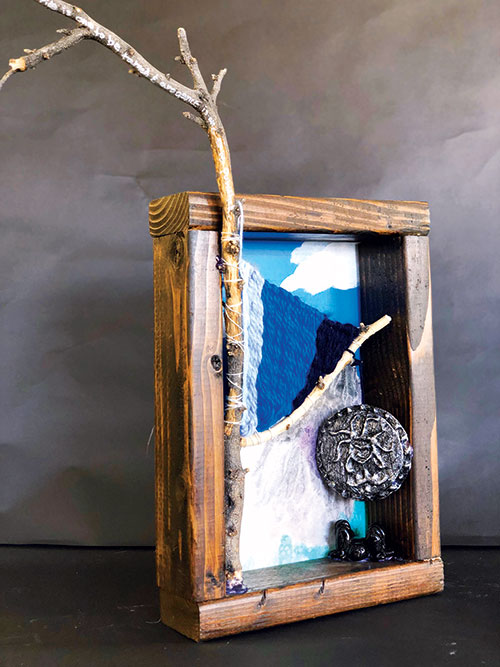 Dominik, Athena and Arachne. Dominik, Athena and Arachne. |
 Yazmin, Aphrodite. Yazmin, Aphrodite. |
Student Introduction
Long ago, in places such as ancient Greece and Rome, people created stories to explain the world around them. These stories explained natural occurrences, such as why the seasons change and where spiders come from. From these stories comes beautiful art. Inspired by artist Joseph Cornell, students from our seventh- and eighth-grade art classes created their own renditions of mythological stories in the form of box sculptures.
Students used a variety of supplies for this project and were encouraged to use techniques inspired by Joseph Cornell, such as using wooden dowels to hang things on, making shelves and drawers, and using collage elements and found objects, such as dolls and light bulbs.
Planning the Boxes
First, students chose and researched a mythological story, such as the story of Arachne, Persephone and Hades, Pandora’s box, or King Midas, and designed a box sculpture that tells the story through symbolism.
Students developed ideas for their sculptures by creating an idea web or listing key parts of the story. They spent a week researching their stories and participated in various activities. In one activity, they explained their stories and designs to each other and wrote feedback on sticky notes. Students were also given the task of composing a quote about their story and finding a way to creatively incorporate it into their piece.
Building the Boxes
Students were each given four pieces of wood to build their boxes. After assembling the boxes, they could either stain or spray paint them to match with that box’s theme. They could also create a background by cutting cardboard to an appropriate size, then spray painting it with a solid color and adding other designs onto it.
After gluing the backgrounds, they added items such as drawings of the characters in their stories; sticks with weavings on them; or a background with flowers, clouds, mountains, oceans, and spiders. Some students even used small pieces of foam to make some of their drawings and/or collage elements pop out.
Incorporating Clay
Students were required to include clay somewhere in their pieces. They were given a sheet of paper and drew what they wanted to make out of clay and wrote two paragraphs or more about how they could create the pieces. When it was time to work with clay, they used the clay planning sheet and roughly followed their plans. They were given three days to create their clay pieces, and the results were beautiful! Students made clay roses, spiders (for Arachne’s story), and rivers (the River Styx from King Midas’s story).
Students made their pieces and added to their boxes as they worked. For example, a student might make the background first, glue it in, make drawings and add them in, and then add clay pieces. This process took lots of planning and troubleshooting.
 Alizae, Arachne. Alizae, Arachne. |
Class-wide Feedback
A week before the project was due, students were given a sheet of paper with three questions to answer about their sculptures, including “How could I possibly improve on my use of space?” When they finished writing, they handed their sheet to a classmate to receive additional feedback and repeated the process with other classmates. After the sheets were filled out, they could use their classmates’ input to improve their pieces.
Student Reflections
According to seventh-grader Danielle Tatro, “This project is like a cake: If you use a messy recipe, the cake will end up crazy. You have to do the cooking by the book, then you’ll have a cake, or in this case, a project.” This project truly was like a cake, with the recipe being the chosen stories, (adding their own ideas would be the frosting and the sprinkles.)
Another student, eighth-grader Alizae Vick states, “There is no real recipe for a genuine art piece.” Although this seems to contradict what Danielle says, Alizae’s “recipe” means that there are no set instructions to an art piece, and you can change it almost any way you want.
Conclusion
This was a lengthy project that lasted two months, but covered so many areas of student learning, from planning their projects to developing art skills within their chosen media. I enjoy mixed-media projects and seeing where the creative process takes my students. Their final projects are always so different from their original plans. That is what makes my job so enjoyable, seeing my young artists grow in their talents.
Sarah Oschmann is an eighth-grade student at Tucson Country Day School in Tucson, Arizona.
Kala Phelps is an art teacher at Tucson Country Day School in Tucson, Arizona. kalafphelps@gmail.com
NATIONAL STANDARD
Creating: Generate and conceptualize new artistic ideas and work.
View this article in the digital edition.


 Dominik, Athena and Arachne.
Dominik, Athena and Arachne. Yazmin, Aphrodite.
Yazmin, Aphrodite. Alizae, Arachne.
Alizae, Arachne.